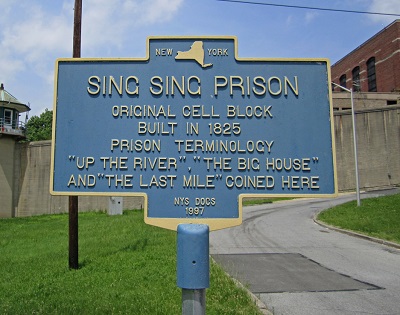MWA-NY members Daniel L Friedman and Eugene B. Friedman write about their experience attending our recent outing to Sing Sing Correctional Facility on July 23.
As we approached the gates of the Sing Sing Correctional Facility and viewed the austere façade for the first time, we were confronted with multiple contrasts. The gorgeous panorama to the west furnishes the illusion that we have entered a fancy resort town. But nothing can be further from the truth.
After getting lost trying to find the parking lot, we asked a woman who had just gotten out of her car if she knew the way to the main entrance. She told us that she was going there and would be happy to walk with us. When we asked if she worked here, she told us, “No,” and with great sadness told us that she was making her bimonthly visit from Albany to visit her 27-year-old son who was incarcerated here for life without any chance for parole. Our hearts almost broke when we heard this. We knew that there were 1,600 other stories like her son’s behind the prison’s barbed wire and pressure-sensitive fence.
A pleasant and friendly security officer manned the exterior’s gate by himself. He ushered us into the administration building’s lobby that was a no-frills affair. On the wall to our left was a plaque commemorating the date, April 14, 1941, when prison guard John Hartye was shot to death by three inmates involved in an escape attempt.
To our right was a rectangular iron gate with locks and vertical steel grids. Above it were the words, “Line Up Room.” The officers were meticulous and unhurried, and everything was double checked. Our contingent had their left hands stamped with invisible ink and had been given identification tags. Soon after, Superintendent Michael Capra introduced himself to us and gave us a slice of Sing Sing’s long history.
Later, Capra and his staff gave us a tour of the grounds and the buildings. Apparently, the only train track that runs directly through any U.S. prison is right here at the Big House, a roofless shell constructed from the stone that gave the prison its name (Sinck Sinck: Stone on Stone). Capra admonished us, “You don’t make eye contact with the prisoners. You walk on the right side of the red line at all times. If you should be attacked by an inmate, move to a wall and stay there. The guards will take care of the situation.”
The first stop inside was the main chapel. Light shone through beautiful stained glass windows. On one of the walls was the commandment: “Inmates are to remain seated until directed to leave by a security staff member.”
From here we went into the cell block, where men dressed in jail green walked passed us seemingly without a care. We toured their weight room, their shower rooms, even their communal kitchen and saw men reading books, writing letters, and watching television. We were shown their outdoor recreational area with its somewhat obsolete body buildings set, as well as their picnic tables and garden. Despite these small amenities, there was no relief from the despair that permeates the prison.
We returned to the conference room, where the staff had set out a nice lunch for us. Our meals certainly cost more than the $2.70 a day that the state spends on each prisoner’s daily meals. After an hour of friendly conversation, Capra took us back to the lineup room where we were shown a mini-documentary, “Voices from Within,” produced by Capra and Daniel Slepian of Dateline. In the film, several inmates wept, baring their souls about the crimes they had committed that had destroyed not only their lives, but also the lives of their families, their victims, and their victim’s loved ones.
As we walked through the door to the outside world, we came away a bit older but wiser, coming away with a new appreciation of just how difficult a task Superintendent Capra and his staff have. We can only say, “Bravo” to them.
—Daniel L Friedman, MD, and Eugene B. Friedman, MD


Nicely written! I missed the memo about not making eye contact. I also didn’t realize that Sing Sing was the only prison that had a train track running through it.
Depending on where you were on the tour, front, middle or back, you saw and heard such different things! A massive subject.
Thank you for sharing this excellent report. I learned some things…and I was there! The comment above, about where you were on the tour, is very true.